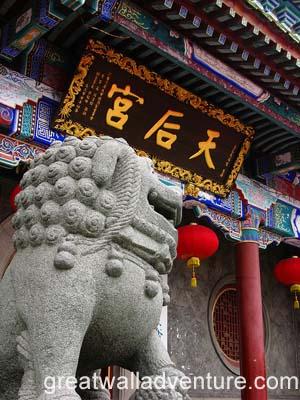|
|
Qingdao Tour of Tianhou
Temple
|
|
Tianhou Temple (Temple of the Queen of Heaven) can be
often seen in China's coastal cities such as Hong Kong and Macau as
well as in the Southeast Asia. It is generally believed that to
worship the Queen of Heaven can ensure the smooth going of the sea
voyage, so every front door of Tianhou Temple is built facing the
sea.
Qingdao Tianhou Temple, built in 1467 of the Ming
Dynasty (1368-1644), is a famous place of interest combining the
marine and folk cultures. Located at No.19, Taiping Road, it is an
ancient architectural structure of strong national characteristics
along the coastline. The temple is a celebrated cultural tourist
attraction and base for studying the folk art of Qingdao.
The whole temple has sixteen buildings and over eighty
rooms, including the main hall, subsidiary halls, wing-rooms, an
opera tower, a bell tower and a drum tower. The opera tower is
covered with glazed tiles, while the other buildings, built with dry
walls and gray tiles, have colored paintings and carvings. Two stone
tablets kept in the temple recorded the restoration of the temple
during the Qing Dynasty (1644-1911). Of all the ancient buildings of
Qingdao, the architectural and painting art of the temple are
inferior to none.
Entering the temple, one will firstly notice the
two-storey resplendent opera tower. The mast and two large stone
lions before the tower make the temple even more magnificent. The
four treasures of the study (writing brush, ink stick, ink slab and
paper) and rare antiques are on display inside. The crossbeams of
the opera tower are painted with exquisite drawings. The bell and
drum towers stand on the sides of the opera tower. The main hall of
the temple is where the Mazu (the Queen of Heaven) is enshrined. The
2.8-meter (9.2 feet) high statue of Mazu, made from camphorwood, is
the largest woodcarving in the world. Besides, many rare ancient
trees are living in the temple which is a blend of typical temple
and inviting garden. A gigantic osmanthus tree presents vermeil
flowers in autumn and the sweet smell attracts many visitors. A male
and a female gingko trees have survived for more than 500 years.
The temple has been turned into a folk custom museum of
Qingdao. Over 100 folk cultural relics are kept in the museum,
including paper-cut, Chinese fancy knots, bead-weaving, clothing
art, agate, calligraphies, paintings, mosaics, poker work and
inside-painting bottles. They are the Qingdao folk art in miniature
and the reflection of Chinese folk art and the museum has become a
market for the folk handicrafts of Qingdao.
Tips: Temple fairs, celebrations and folk activities
are held from May 1st to 7th and on March 23rd of Chinese lunar
calendar when the Mazu was born.
Tour Qingdao with Great Wall
Adventure Club, the best Qingdao tour agent to help you with
your hotel booking and transfers. |
|

